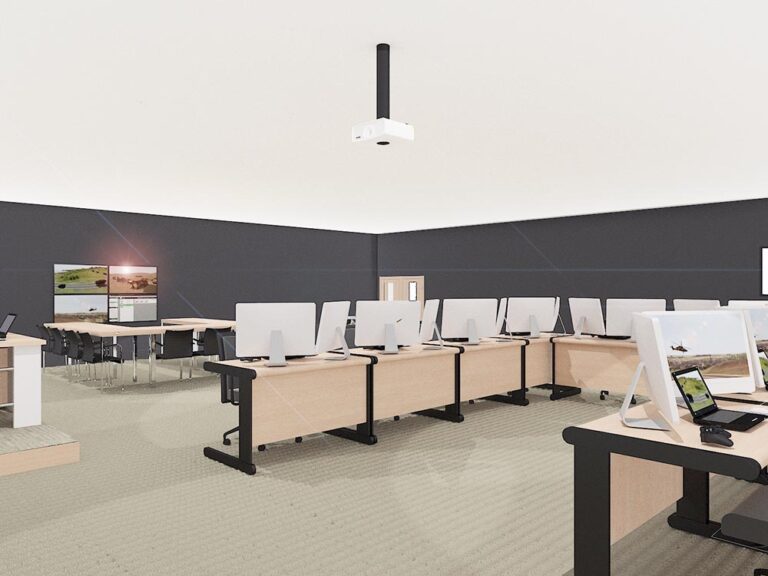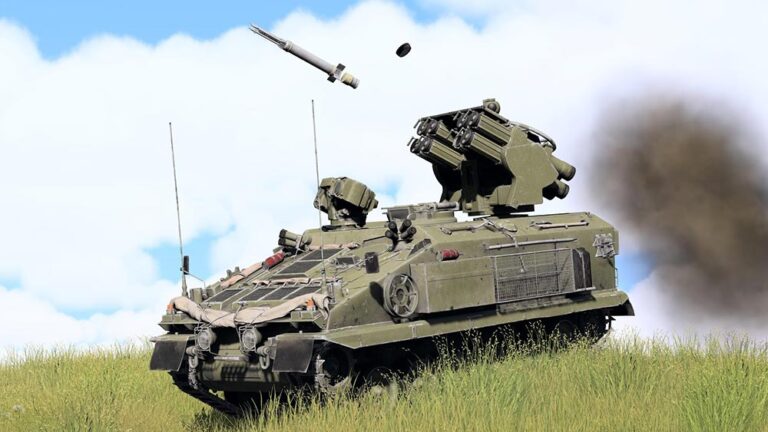The first scene: massive noise and vibration as the entire troop of Main Battle Tanks (MBTs) fires on a lone emerging target. The second scene: a single MBT destroys the lone target with just one hit, and the tank troop rumbles on in perfect formation. The first scene was commonplace as tank units conducted their annual gunnery training live in the days before virtual simulation. (A waste of ammunition and a failure of control, of course.) The second scenario is what typically happens after tank crews have used simulation to iron out all of the kinks in their Tactics, Training and Procedures before going onto the gunnery ranges. That is the power of COTS-based (Commercial-Off-The-Shelf) virtual simulation done in what armies call battle labs.
Another actual event, taking place one morning: An Infantry Fighting Vehicle (IFV) crew are “on exercise” in a VBS battle lab, chatting to each other in the style soldiers uniquely use. Suddenly, the vehicle’s systems die on their screens and messages tell them that the vehicle has suffered a direct hit. They are out of the exercise, puzzled faces all around! A soldier from another callsign walks over and asks why they didn’t respond to the radio chat about enemy forces. The blame game in the crew begins. (It wasn’t clear until the VBS After Action Review (AAR) whether the IFV crew were too busy joking around or on the wrong radio channel.) Better to learn (relearn!) hard lessons in the battle lab than in the real vehicle! Next event, the same crew in that afternoon’s simulation exercise: Focused, determined and aggressive, the crew blitzed every enemy the virtual training exercise put in front of them. That is the power of training immersion!

Defining Battle Labs
So what are battle labs and how are they used? Battle labs are dedicated computer-equipped classrooms on military sites, where groups of soldiers learn drills and tactical procedures in the virtual world on operationally realistic or relevant virtual ‘terrains’. Soldiers work collaboratively, in voice and radio communications with their colleagues, and with real-world situational awareness. Units can work up from simple drills to actual tactics, unopposed, against other players (or exercise controllers) or against powerful Artificial Intelligence forces. There is a full VBS AAR capability to cement learning. A typical such classroom may have 20-30 trainee stations plus stations for instructors and administrators.
A battle lab works for any arm of the army, light and mechanized infantry, reconnaissance, heavy armour, engineering, logistics, artillery, rotary wing, amphibious, specialist and regular alike. Just add steering wheels, joysticks and headsets for comms, and you have a room full of tactical crew trainers.
Essentially, your battle lab is highly reconfigurable according to the day’s training audience. Add the same hand controllers that you have in-vehicle, and you’re building muscle memory as well as tactical skills.
Of course, it’s a short step from basic training to dedicated virtual exercises. Such exercises save money, time, travel, track miles and the environment, and keep soldiers at ‘home base’. Virtual exercises can link units together in different locations to exercise together – which doing for real takes significant planning and coordination – it’s not an everyday occurrence! Sometimes virtual exercises are international, for example, allowing British and Australian soldiers to train together in an area of operations where they will carry out a joint live exercise months later.

Battle Lab Benefits
In the real world, operations are complex. Command and control and working with different arms (e.g., infantry with armour, armour with artillery, ground with rotary and fast air) take time to become second nature. Such “All-Arms” training is infrequent, as scheduling, availability, weather, cost and other factors conspire against it being simple to organise. Some operations, such as live fire with armour and/or close air support, are inherently dangerous and so such live training (when available) is heavily scripted or constrained. As one major western army’s reservists (a Light Cavalry unit) discovered during the 2020 pandemic, virtual simulation allowed them to virtually train (with the power of Artificial Intelligence) with units (e.g., artillery) that reservists would hardly ever encounter in their time-limited training schedules. For such reservists, their links to the battle lab were from their homes – ideal for training in pandemic times!
It’s no surprise that some major NATO armies are looking to redesign their training philosophies with a greater virtual simulation component, using VBS3 or BISim’s new VBS4 for example. The reasons for such shifts include greater adaptability and agility – making training relevant by rapidly matching it (in the immersive virtual world) to the ever-evolving real world threat. Others want to use more virtual simulation to allow greater complexity of training, closely mirroring what soldiers will experience on operations. Others need to increase their training throughput or do more with the same resources.
This ambition for increased simulation training is driven by evidence that virtual simulation, when blended to complement live training, improves performance, increases course pass rates and lowers training cost. A classic academic paper on this, by way of example, is one in 2008 by Roman and Brown that is widely available on the internet. In 2018, the British Army stated: “There will be greater use of virtual training and a paradigm shift to ‘virtual before live’, where live training is used to consolidate and confirm skills learned in a virtual environment.”

Vision from Past Shapes Battle Lab’s Future
Militaries are also looking at VR headsets in battle labs to further increase soldiers’ training immersion, and excellent results have been achieved with VBS3 and VBS4 for this. VR headsets, that anyone can buy in a store, are relatively cheap by military procurement standards and show the power of “COTS”: commercially available simulation software and IT hardware you can buy in-store. This makes battle lab training supportable, future-proofed, and affordable.
Battle labs have come a long way from 1996, when the Commandant of the United States Marine Corps (USMC), Gen. Charles C. Krulak, issued a directive aimed at implementing improvements in what he termed “Military Thinking and Decision Making Exercises”. In his guiding comments, Krulak wrote: “It is my intent that we reach the stage where Marines come to work and spend part of each day talking about warfighting: learning to think, making decisions, and being exposed to tactical and operational issues.” (Interestingly, the USMC was the first customer for VBS1, the forerunner to today’s VBS4, the leading tactical simulation training software.)
Krulak identified that, “The use of technological innovations, such as personal computer (PC)-based wargames, provide great potential for Marines to develop decision making skills, particularly when live training time and opportunities are limited. Policy contained herein authorizes Marines to use Government computers for approved PC-based wargames”.
What Krulak wanted to achieve in his vision is now practiced around the world. In use by some of the world’s best-trained and equipped armed forces in the U.S., Canada, UK, France, Germany and Australia, to name just a very few, VBS software trains over half a million soldiers, sailors and airmen around the globe each year.
What has greatly changed since 1996 are not the benefits of best-of-breed virtual simulation training in battle labs. Rather, Krulak’s aims are even more realisable and closer to operational training needs by the power of today’s hardware and the capabilities of software such as VBS4. Such training is also easier to grasp – VBS4 was designed for its ease of use for soldiers, not for software engineers and specialised administrators.
Battle lab training is now in every army’s grasp. And it has never been more accessible or relevant.
For more details of what a battle lab is, how you can use it or set it up, or for a demonstration, just contact sales@bisimulations.com.

